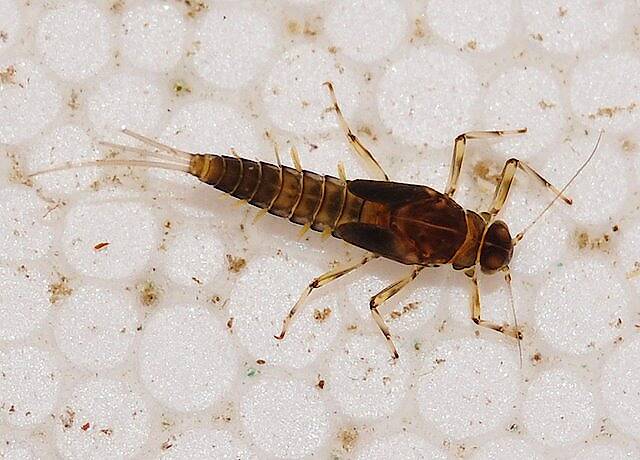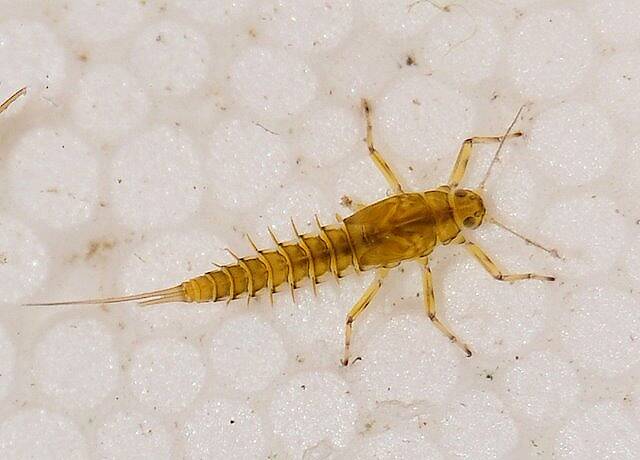
Blue-winged Olives
Baetis
Tiny Baetis mayflies are perhaps the most commonly encountered and imitated by anglers on all American trout streams due to their great abundance, widespread distribution, and trout-friendly emergence habits.
Featured on the forum

This specimen appears to be of the same species as this one collected in the same spot two months earlier. The identification of both is tentative. This one suffered some physical damage before being photographed, too, so the colors aren't totally natural. I was mostly photographing it to test out some new camera setting idea, which worked really well for a couple of closeups.

Troutnut is a project started in 2003 by salmonid ecologist Jason "Troutnut" Neuswanger to help anglers and
fly tyers unabashedly embrace the entomological side of the sport. Learn more about Troutnut or
support the project for an enhanced experience here.


DOS on Mar 18, 2009March 18th, 2009, 8:06 pm EDT
Hello gents,
I collected these specimens today on a Western New York Spring Creek. I'm wondering if you can tell me what inferences I can make regarding development and sex, based on physical observation of these two Baetidae nymphs.
I collected these specimens today on a Western New York Spring Creek. I'm wondering if you can tell me what inferences I can make regarding development and sex, based on physical observation of these two Baetidae nymphs.
Andrew Nisbet
Taxon on Mar 19, 2009March 19th, 2009, 4:01 am EDT
Hi Andrew,
I salute your curiosity. With regard to development, the 1st specimen with darkened wing pads would likely be in its last nymphal instar, and very close to time of emergence, whereas the 2nd specimen with wing pads of approximately same size might be of same or previous instar, and not as close to time of emergence. With regard to sex, I know of nothing which can be inferred from photos of mayfly nymphs.
I salute your curiosity. With regard to development, the 1st specimen with darkened wing pads would likely be in its last nymphal instar, and very close to time of emergence, whereas the 2nd specimen with wing pads of approximately same size might be of same or previous instar, and not as close to time of emergence. With regard to sex, I know of nothing which can be inferred from photos of mayfly nymphs.
GONZO on Mar 19, 2009March 19th, 2009, 8:00 am EDT
Andrew,
The nymph in the top photo is a male, and the other is probably a female. Sexually dimorphic traits like differences in body size and eye size can be seen in mature mayfly nymphs of many species, but these comparative differences can be a bit hard to interpret in photos unless both sexes can be seen side by side. Additionally, the developing claspers of males can sometimes be seen in mature nymphs (though these usually don't show in dorsal photos).
However, because these are baetid nymphs, the turbinate eyes of the males (the large reddish set of eyes on top of the head of the nymph in the first photo) can be seen on mature nymphs.
If I had to guess, I'd lean toward these being male and female B. tricaudatus nymphs. Many baetid nymphs also have different male/female color forms, and these seem to match up well with that species.
The nymph in the top photo is a male, and the other is probably a female. Sexually dimorphic traits like differences in body size and eye size can be seen in mature mayfly nymphs of many species, but these comparative differences can be a bit hard to interpret in photos unless both sexes can be seen side by side. Additionally, the developing claspers of males can sometimes be seen in mature nymphs (though these usually don't show in dorsal photos).
However, because these are baetid nymphs, the turbinate eyes of the males (the large reddish set of eyes on top of the head of the nymph in the first photo) can be seen on mature nymphs.
If I had to guess, I'd lean toward these being male and female B. tricaudatus nymphs. Many baetid nymphs also have different male/female color forms, and these seem to match up well with that species.
DOS on Mar 20, 2009March 20th, 2009, 8:57 am EDT
Hey guys,
Thanks for the insight. Your responses inspired lots of googling and book cracking in search of more questions and answers.
After thinking about these two nymphs and the location I collected them, I remembered that I encounter a Baetidae hatch in the same place last year at about this time, that offered up excellent fishing. I went back and checked my photo records and journal, sure enough I have pictures of the adults.
The insects were consistently a size 16. I'm fairly certain I can associate these two adults, male and female with the nymphs. Do you concur? Is it sound to make such an assumption?


Also.... I had this lovely lady emerge last night in my bug rearing aquarium. I found her this morning laying on her side in the surface film, not moving, with her wings crumpled. I took her out of the water, lifeless, assuming she was dead. I walked away to get the camera and when I came back she was upright and walking around.

Thanks for the insight. Your responses inspired lots of googling and book cracking in search of more questions and answers.
After thinking about these two nymphs and the location I collected them, I remembered that I encounter a Baetidae hatch in the same place last year at about this time, that offered up excellent fishing. I went back and checked my photo records and journal, sure enough I have pictures of the adults.
The insects were consistently a size 16. I'm fairly certain I can associate these two adults, male and female with the nymphs. Do you concur? Is it sound to make such an assumption?


Also.... I had this lovely lady emerge last night in my bug rearing aquarium. I found her this morning laying on her side in the surface film, not moving, with her wings crumpled. I took her out of the water, lifeless, assuming she was dead. I walked away to get the camera and when I came back she was upright and walking around.

Andrew Nisbet
GONZO on Mar 20, 2009March 20th, 2009, 1:59 pm EDT
Andrew,
The top two photos look like male and female B. tricaudatus duns, and size #16 is about right for the early brood. Later-hatching broods become successively smaller.
The top two photos look like male and female B. tricaudatus duns, and size #16 is about right for the early brood. Later-hatching broods become successively smaller.
Martinlf on Mar 20, 2009March 20th, 2009, 2:13 pm EDT
Great photos of my favorite may. Thanks.
"He spread them a yard and a half. 'And every one that got away is this big.'"
--Fred Chappell
--Fred Chappell
Quick Reply
Related Discussions
Topic
Replies
Last Reply
4
Sep 27, 2014
by Millcreek
by Millcreek
7
Sep 18, 2006
by Troutnut
by Troutnut
0
Aug 12, 2012
by Hdhungryman
by Hdhungryman
1
Jun 22, 2017
by Crepuscular
by Crepuscular


















